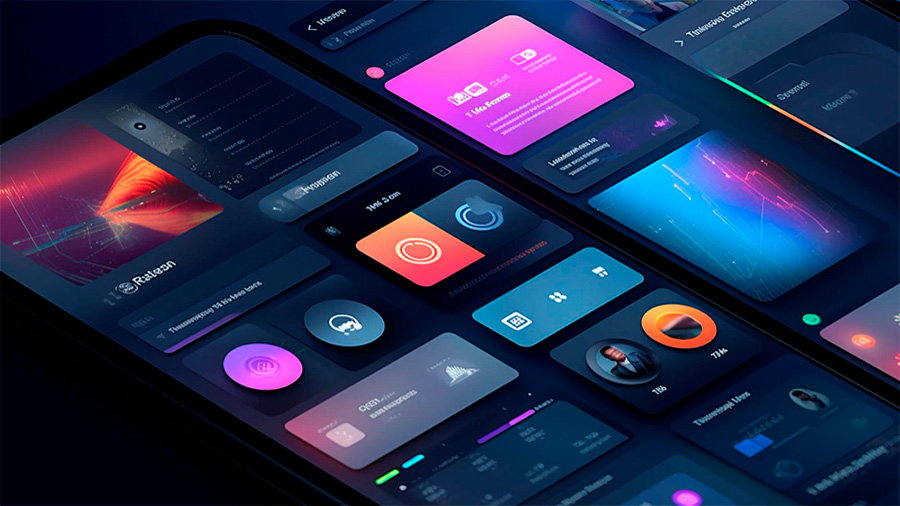UX and UI design, though often used interchangeably, refer to different aspects of the web development process. Both are essential for creating a website that is not only visually appealing but also functional and user-friendly.
User Experience (UX) Design
UX design focuses on the overall experience users have when interacting with a website. It encompasses various elements, including usability, accessibility, and the overall flow of the website. The goal of UX design is to create a seamless, intuitive, and enjoyable experience for users.
- User research and personas
- Information architecture
- Wireframing and prototyping
- Usability testing and feedback
User Interface (UI) Design
UI design, on the other hand, is concerned with the visual elements of a website. It involves designing the layout, typography, color schemes, and interactive elements that users interact with. The goal of UI design is to create an aesthetically pleasing and cohesive visual experience.
- Visual design and branding
- Typography and color theory
- Interactive elements and animations
- Consistency and coherence

The Importance of UX Design
UX design plays a pivotal role in determining how users interact with a website and whether they have a positive experience. Here’s why UX design is essential in web development:
Enhanced Usability
A well-designed UX ensures that a website is easy to navigate and use. By organizing content logically and providing clear navigation paths, UX design helps users find the information they need quickly and effortlessly.
For example, intuitive navigation menus and search functions can significantly improve usability, reducing the time users spend searching for information.
Increased User Satisfaction
A positive user experience leads to higher levels of satisfaction. When users find a website easy to use and enjoyable to interact with, they are more likely to return and recommend it to others.
High user satisfaction can result in increased engagement, longer visit durations, and higher conversion rates.
Better Accessibility
UX design prioritizes accessibility, ensuring that websites are usable by people with disabilities. This includes implementing features such as screen reader compatibility, keyboard navigation, and high-contrast text.
Improving accessibility not only broadens your audience but also demonstrates a commitment to inclusivity and social responsibility.
Lower Bounce Rates
A poorly designed user experience can lead to high bounce rates, where users leave the website shortly after arriving. By providing a seamless and engaging experience, UX design helps keep users on the site longer.
Reducing bounce rates can lead to higher search engine rankings and improved overall website performance.

The Importance of UI Design
While UX design focuses on the overall experience, UI design is essential for creating an attractive and engaging visual presentation. Here’s why UI design is critical in web development:
First Impressions Matter
The visual appeal of a website is often the first thing users notice. A well-designed UI can create a positive first impression, encouraging users to explore further.
A visually appealing design can convey professionalism, trustworthiness, and attention to detail, setting the tone for the user’s experience.
Brand Identity
UI design plays a crucial role in establishing and reinforcing brand identity. Consistent use of colors, typography, and design elements helps create a cohesive brand image.
Strong brand identity can enhance recognition, build trust, and differentiate your website from competitors.
Enhanced User Engagement
Interactive and visually appealing UI elements can enhance user engagement. Animations, hover effects, and interactive buttons can make the website experience more dynamic and enjoyable.
Engaging UI design can encourage users to interact with the website, explore content, and complete desired actions.
Clear Visual Hierarchy
UI design helps establish a clear visual hierarchy, guiding users’ attention to important elements and content. Effective use of layout, spacing, and contrast can make information more digestible and easier to understand.
Clear visual hierarchy improves readability and helps users quickly grasp the key messages and actions.
Integrating UX and UI Design for Success
The integration of UX and UI design is essential for creating successful websites. Here’s how combining both aspects can lead to optimal results:
Holistic User Experience
By integrating UX and UI design, developers can create a holistic user experience that is both functional and visually appealing. This ensures that users not only enjoy using the website but also find it easy to navigate and interact with.
Combining intuitive navigation with attractive design elements creates a seamless and enjoyable experience.
Consistent Design Language
Consistency in design language across UX and UI elements helps create a cohesive and professional look. This includes using consistent fonts, colors, and design patterns throughout the website.
Consistent design language enhances usability and reinforces brand identity.
Responsive and Adaptive Design
Integrating UX and UI design ensures that websites are responsive and adaptive to different devices and screen sizes. This provides a consistent and optimized experience for users, regardless of how they access the site.
Responsive design improves accessibility and ensures that users have a positive experience on both desktop and mobile devices.
Iterative Improvement
Combining UX and UI design allows for continuous improvement through iterative design processes. Regular usability testing and user feedback can inform updates and refinements, ensuring that the website evolves to meet user needs.
Iterative improvement helps maintain a high standard of user satisfaction and keeps the website relevant and effective.
Case Study: Enhancing a Website Through UX/UI Design Integration
A retail e-commerce website was struggling with high bounce rates and low conversion rates. The development team decided to integrate UX and UI design principles to enhance the website’s performance.
- Enhanced Usability: The team conducted user research to identify pain points and redesigned the navigation to be more intuitive. They implemented a clear information architecture and added search functionality.
- Increased Visual Appeal: UI designers revamped the visual design, using a consistent color scheme, modern typography, and engaging visuals to create a more attractive interface.
- Improved Accessibility: The website was optimized for accessibility, including features like keyboard navigation, screen reader compatibility, and high-contrast text options.
- Interactive Elements: The UI design incorporated interactive elements such as hover effects, animations, and call-to-action buttons to enhance user engagement.
- Regular Testing and Feedback: The team conducted regular usability testing and gathered user feedback to iteratively improve the website design.
As a result, the website saw a significant reduction in bounce rates, increased user engagement, and higher conversion rates. The integration of UX and UI design principles led to a more successful and user-friendly website.
Conclusion
The integration of UX and UI design is essential for creating successful websites that are both functional and visually appealing. UX design focuses on enhancing usability, accessibility, and overall user satisfaction, while UI design emphasizes creating an attractive and engaging visual presentation. By combining these elements, developers can create a holistic user experience that drives engagement, reduces bounce rates, and boosts conversions. As demonstrated by the case study, the effective integration of UX and UI design can lead to significant improvements in website performance and user satisfaction.



